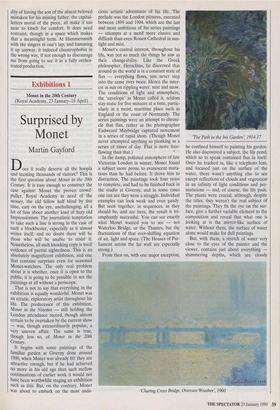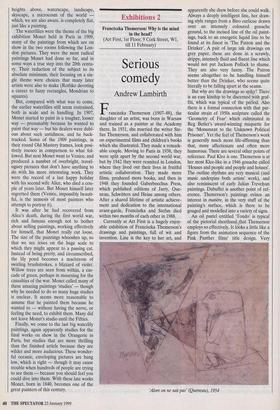Exhibitions 1
Monet in the 20th Century (Royal Academy, 23 January-18 April)
Surprised by Monet
Martin Gayford
Does it really deserve all the hoopla and teeming thousands of visitors? This is the first question about Monet in the 20th Century. It is easy enough to construct the case against: Monet the proven crowd- puller, Royal Academy in need of the money, the old fellow half blind by this time, easy on the eye, unchallenging, all a lot of fuss about another load of hazy old Impressionism. The journalistic temptation to take such a line is strong in the case of such a blockbuster, especiallSr as it almost writes itself, and no doubt there will be those who will be unable to resist it. Nonetheless, all such knocking copy is itself evidence of partial sightedness. This is an absolutely magnificent exhibition, and one that contains surprises even for seasoned Monet-watchers. The only real problem about it is whether, once it is open to the public, it is going to be possible to see the paintings at all without a periscope.
That is not to say that everything in the exhibition is equally wonderful. Monet was an erratic, exploratory artist throughout his life. The predecessor of this exhibition, Monet in the Nineties — still holding the London attendance record, though almost certain to be overtaken by the current show — was, though extraordinarily popular, a very uneven affair. The same is true, though less so, of Monet in the 20th Century.
It begins with some paintings of the familiar garden at Giverny done around 1900, when Monet was already 60; they are attractive enough, but if he had achieved no more in his old age than such mellow continuations of earlier work it would not have been worthwhile staging an exhibition such as this. But, on the contrary, Monet was about to embark on the most auda- cious artistic adventures of his life. The prelude was the London pictures, executed between 1899 and 1904, which are the last and most ambitious of his series paintings — attempts at a motif more elusive and difficult than even Rouen Cathedral in sun- light and mist.
Monet's central interest, throughout his life, was not so much the things he saw as their changeability. Like the Greek philosopher, Heraclitus, he discerned that around us the world is in a constant state of flux — everything flows, you never step into the same river twice. Hence the inter- est in sun on rippling water, mist and snow. The conditions of light and atmosphere, the 'envelope' as Monet called it, seldom stay static for five minutes at a time, partic- ularly in a moist, maritime place such as England or the coast of Normandy. The series paintings were an attempt to chroni- cle that flux, rather as the photographer Eadweard Muybridge captured movement in a series of rapid shots. (Though Monet never attempted anything so plonking as a series of times of day. Flux is more free- flowing than that.) • In the damp, polluted atmosphere of late Victorian London in winter, Monet found a subject more prone to evanescent muta- tions than he had before. It drove him to distraction. The paintings took four years to complete, and had to be finished back in the studio at Giverny, and in some cases one can see they were a struggle. Individual examples can look weak and even gaudy. But seen together, in sequences, as they should be, and are here, the result is tri- umphantly successful. You can see exactly what Monet wanted you to see — not Waterloo Bridge, or the Thames, but the fluctuations of that ever-shifting equation of air, light and space. (The Houses of Par- liament across the far wall are especially strong.) From then on, with one major exception, `The Path in the Iris Garden, 1914-17 he confined himself to painting his garden. He also discovered a subject, the lily pond, which so to speak contained flux in itself. Once he tracked in, like a telephoto lens, and focused just on the surface of the water, there wasn't anything else to see except reflections of clouds and vegetation in an infinity of light conditions and per- mutations — and, of course, the lily pads. The plants were crucial, although, despite the titles, they weren't the real subject of the paintings. They fix the eye on the sur- face, give a further variable element to the composition and reveal that what one is looking at is the mirror-like surface of water. Without them, the surface of water alone would make for dull paintings.
But, with them, a stretch of water very close to the eyes of the painter and the viewer, contains just about everything shimmering depths, which are cloudy `Charing Cross Bridge, Overcast Weather, 1900 heights above, waterscape, landscape, skyscape, a microcosm of the world which, we are also aware, is completely flat, just like a painting.
The waterlilies were the theme of the big exhibition Monet held in Paris in 1909, many of the paintings from which are on show in the two rooms following the Lon- don pictures. They were the most radical paintings Monet had done so far, and in some ways a true step into the 20th centu- ry. Their reduction of the subject to its absolute minimum, their focusing on a sin- gle theme were choices that many later artists were also to make (Rothko devoting a career to fuzzy rectangles, Mondrian to squares).
But, compared with what was to come, the earlier waterlilies still seem restrained, both in scale and in handling. In 1907, Monet started to paint in a tougher, looser way — presumably because he wanted to paint that way — but his dealers were dubi- ous about such untidiness, and he back- tracked. Some of the 1909 paintings, in their round Old Mastery frames, look posi- tively rococo in comparison to what fol- lowed. But next Monet went to Venice, and produced a number of overbright, travel- oguey pictures that don't have anything to do with his more interesting work. They were the record of a last happy holiday with his second wife Alice, who died a cou- ple of years later. But Monet himself later regretted them (Venice, impossibly beauti- ful, is the nemesis of most painters who attempt to portray it).
It was after he had recovered from Alice's death, during the first world war, rich and famous enough not to bother about selling paintings, working effectively for himself, that Monet really cut loose. The size of the paintings whooshes up, so that we see irises on the huge scale to which they might appear to a passing cat. Instead of being pretty, and circumscribed, the lily pond becomes a maelstrom of swirling brushstrokes, a blizzard of violet. Willow trees are seen from within, a cas- cade of green, perhaps in mourning for the casualties of the war. Monet called many of these amazing paintings 'studies' — though why he needed to do so many huge studies is unclear. It seems more reasonable to assume that he painted them because he wanted to — without having the nerve, or feeling the need, to exhibit them. Many did not leave Monet's studio until the Fifties.
Finally, we come to the last big waterlily paintings, again apparently studies for the final works on show in the Orangerie in Paris, but studies that are more thrilling than the finished article because they are wilder and more audacious. These wonder- ful oceanic, enveloping pictures are hung low, which is right — though it may cause trouble when hundreds of people are trying to see them because you should feel you could dive into them. With these late works Monet, born in 1840, becomes one of the great painters of this century.



























































 Previous page
Previous page